Viscose and modal are both semi-synthetic fibers derived from cellulose, but modal offers enhanced softness, breathability, and durability compared to viscose, making it ideal for premium clothing. Your choice depends on the desired fabric feel and longevity, with modal better suited for garments requiring frequent washing and superior comfort.
Table of Comparison
| Feature | Viscose | Modal |
|---|---|---|
| Material Source | Made from wood pulp, primarily beech, pine, or eucalyptus | Made from beech tree pulp, a type of rayon |
| Texture | Soft, smooth, and silk-like | Extra soft, silky, and breathable |
| Durability | Moderate; prone to weakening when wet | High; stronger when wet, more durable than viscose |
| Breathability | Good breathability | Excellent breathability |
| Moisture Absorption | Absorbs moisture well but dries slowly | Absorbs moisture effectively and dries faster |
| Eco-Friendliness | Less sustainable; uses chemicals in production | More eco-friendly; uses less chemicals, partially biodegradable |
| Care | Delicate; hand wash or gentle cycle recommended | Easy care; machine washable and resistant to shrinkage |
| Common Uses | Apparel, linings, upholstery | Activewear, underwear, bedding |
Introduction to Viscose and Modal
Viscose and Modal are both semi-synthetic fibers derived from wood pulp, known for their softness, breathability, and drape, making them popular in fashion and home textiles. Viscose, often called rayon, is a versatile fiber with a smooth texture but can be less durable and prone to shrinking when wet. Modal, a type of viscose, undergoes a more refined production process, resulting in stronger, more elastic fabric that retains its shape and color better over time, enhancing your comfort and garment longevity.
Origins and Production Processes
Viscose is derived from regenerated cellulose fibers extracted from wood pulp, primarily using a chemical-intensive production process involving carbon disulfide, while Modal is a type of rayon made from beech tree cellulose through a similar but more environmentally friendly method. Both viscose and modal undergo wet spinning to create soft, breathable fabrics, though modal's production includes additional steps that enhance fiber strength and flexibility. Understanding the origins and manufacturing distinctions between viscose and modal can help You make informed choices about fabric sustainability and performance.
Material Composition and Structure
Viscose is made from regenerated cellulose fibers derived from wood pulp, featuring a smooth, semi-synthetic structure that mimics natural fibers like cotton. Modal, a type of rayon, undergoes a specialized reprocessing of beech tree cellulose, resulting in finer, stronger, and more flexible fibers with enhanced moisture absorbency. The structural differences in fiber processing give modal superior durability and softness compared to standard viscose.
Environmental Impact Comparison
Viscose production involves significant water usage and chemical-intensive processes that contribute to deforestation and water pollution, resulting in a higher environmental impact compared to modal. Modal, derived from beech trees through a more sustainable closed-loop production method, uses fewer chemicals and less water, making it environmentally friendlier. Both fibers are biodegradable, but modal's eco-efficient manufacturing practices position it as a preferable choice in terms of reducing ecological footprint.
Comfort and Wearability
Viscose and modal fabrics both offer excellent comfort, with modal providing a softer, smoother feel due to its finer fibers and higher moisture-wicking ability. Modal maintains its shape and softness after multiple washes, making it more durable and ideal for everyday wear. While viscose is breathable and lightweight, modal's enhanced stretch and resilience deliver superior wearability and long-lasting comfort.
Durability and Longevity
Viscose and Modal are both semi-synthetic fibers derived from cellulose, but Modal offers superior durability and longevity compared to Viscose due to its stronger fiber structure and higher wet strength. Your clothing made from Modal tends to retain shape, resist pilling, and withstand frequent washing better than Viscose, which is more prone to weakening and losing its texture over time. Choosing Modal ensures longer-lasting garments that maintain their softness and appearance through extended use.
Care and Maintenance
Viscose requires gentle washing in cold water and should be air-dried to prevent shrinkage and loss of texture, as it is prone to damage from heat and agitation. Modal fibers are more durable and resistant to shrinkage, allowing for machine washing on a gentle cycle and tumble drying on low heat without compromising fabric softness or shape. Both fabrics benefit from avoiding bleach and harsh detergents to maintain color vibrancy and fiber integrity over time.
Cost and Availability
Viscose is generally more affordable than modal, making it a popular choice for budget-conscious consumers, while modal tends to be pricier due to its more complex production process. Both fibers are widely available, but viscose is more commonly found in mainstream textile markets worldwide, whereas modal is often marketed as a premium, sustainable alternative. The cost differences stem from modal's superior softness and durability, which appeal to higher-end applications in fashion and home textiles.
Popular Uses in Fashion and Textiles
Viscose and modal are both popular semi-synthetic fibers derived from cellulose, extensively used in fashion and textiles for their softness and drape. Viscose is widely favored for everyday clothing such as blouses, dresses, linings, and scarves due to its breathability and affordability, while modal is prized for high-end activewear, underwear, and luxury loungewear because of its superior durability and moisture-wicking properties. Your choice between viscose and modal can impact the longevity and comfort of garments, making modal ideal for items requiring frequent washing and viscose suitable for light, delicate apparel.
Choosing Between Viscose and Modal
Choosing between viscose and modal depends on your preference for fabric durability and softness. Modal typically offers greater strength and a smoother feel, making it ideal for everyday wear, while viscose provides a breathable and lightweight texture perfect for summer clothing. Consider the specific use and care requirements to determine which fabric best suits your wardrobe needs.
Viscose vs Modal Infographic

 libmatt.com
libmatt.com